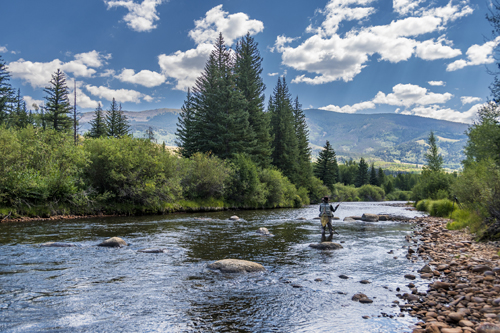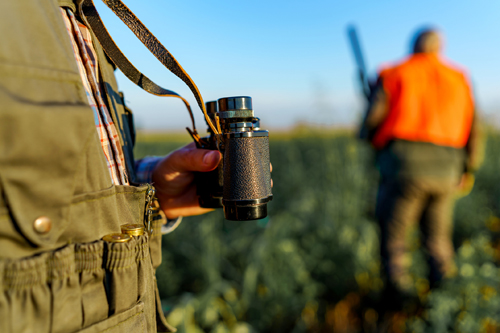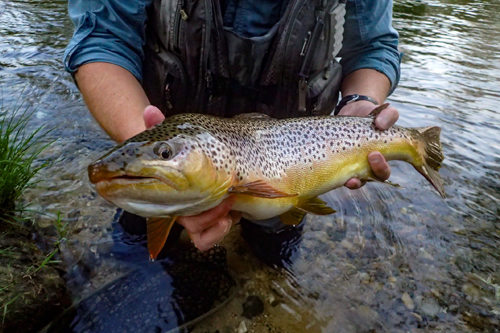ACI Grants & Resources
The Association for Conservation Information, through Multistate Conservation Grants, works with its members to make important investments for the future of conservation.
Current grant projects:
By 2020, approximately 11% of Americans 16 and older went target shooting annually, but only 9% of youth from 9 to 15 years participated. Similarly, 61% of hunters had started by the age of 17 (DOI, DOJ, Southwick). Recognizing most adults adopt their preferred recreational activities in their youth, the future of target shooting and its correlated conservation funding mandates that young people have safe opportunities to try the sport. However, considering a majority of youth live in urban and suburban areas, with most in non-shooting or non-hunting households, the opportunity for youth to try target shooting is limited. It is paramount we bring shooting education opportunities to youth where they live rather than expect them to find us. Read more.
The purpose of this project is to put tested messages on the ground to achieve recruitment, retention, and reactivation (R3) through podcast and streaming audio ads in 4 pilot states in the Southeastern US. Working with representatives from each state and the National Deer Association, we will develop audio ads for placement in each state. We will use the research funded in by the Multistate Conservation Grant Program #F22AP01126 that developed new Hunter Personas and develop ad creative around each of the personas and target the messages developed to Family Firsts, Self Sufficients, Locavores, and Recreationalists. Then measure success at increasing participation by using their license purchase behavior to determine success using pixel tracking technology. The persona research found here in the R3 Clearinghouse recommends placing ads in streaming or podcasts as these targeted groups engage with that medium very often. On top of that research, in 2023 podcast listeners increased to 164 million in the US and listenership has increased 60% since 2020. Of all podcast listeners, almost half (47%) are aged 12-34 years. 33% are 35 to 54-year-olds. And the remaining 20% are aged 55+ years. The majority of podcast listeners are male (53%). These stats lend to podcasting and streaming ads being a good marketing investment to accomplish R3. Read more.
R3 through marketing is the project’s purpose. Using 5 trial state Fish and Wildlife agencies, we will implement marketing efforts via a $50,000 grant each to accomplish recruitment, retention, and reactivation of hunters and/or target shooters as this project has successfully done since 2020. The Association for Conservation Information (ACI) along with Wildlife Management Institute (WMI) will open applications for states to apply for grant funds for a marketing campaign that they would like to do. We will select the 5 best proposals as scored by ACI/WMI committee and implement them. The 5 trial states will complete their marketing campaigns within the 2025 calendar year and develop a case study. Expected outcomes include:
- Increased participation as indicated by engagement with marketing assets and number of licenses sold linked to campaign.
- Case studies for other states to learn from.
- Help states learn marketing strategies and try new things.
Past Grant Projects & Case Studies
Developed a series of videos of young, diverse adults having a fun weekend in the woods. Laughing over the campfire, exploring together, and building memories. Content captured was leveraged for a campaign overview video and short clips for social media organic posts. WRD developed a page on its website to host the video along with supporting content on why you should make your weekend plans outdoors with friends, and what you need to know. Results were better than expected and we believe the quality and variations of the creative played a big part in that. Video production took place from November to December. Ads were live starting January 15 till March with regular monitoring and access to real-time data dashboard to view digital ad performance metrics, as well as website analytics. Read more.
We partnered with Brandt Information Services and Modern Legacy to create a marketing pathway that leads a recreational shooting enthusiast to buy a hunting license and/or pay the habitat fee. Highly targeted digital ads leveraged with pixel-tracking and utm-tagging tactics to measure view-through and click-through conversions generated from users who saw Iowa DNR’s digital ads (current Iowa hunting license customers excluded) as well as click-through traffic generated from the campaign webpages. The complex digital advertising campaign used industry best practices to target users based on profile and online behaviors. Read more.
ODWC is making R3 work a top priority now and for the foreseeable future, both through its recently completed agency strategic plan and through staffing. Grant dollars helped maintain positive R3 momentum, especially as it related to driving hunting license sales among new and lapsed customers during January – March 2021 when marketing funds would otherwise be depleted. December had digital ads and text messages promoting antlerless deer harvest awareness and licensing to new and lapsed customers. January had digital ads promoting new license year awareness for newly lapsed customers. February’s ads were for lapsed customers and March digital ads and text messages were for lapsed spring turkey license holders highlighting the upcoming season. Read more.
Most R3 Marketing digital advertising campaigns across the nation today are geared towards increasing resident hunters. Virginia, similar to most of the northeast and southeast, is a short drive for nonresidents to come visit and go hunting. We are missing out on a great opportunity by only targeting residents. This year in particular, with people considering family vacations within a short driving distance, was a great opportunity to highlight the great things Virginia has to offer. When a person goes hunting in their home state, and then takes a hunting trip out of state, it increases their avidity for the sport creating higher likelihood of retention. The campaign was a success, proving over a 6.69 Return On Investment (ROI). In addition, the full GoOutdoorsVirginia system had an overall 22.4% increase in nonresident hunting license revenue compared to previous license year. Read more.
Our agency depends on hunting license purchases and associated federal aid dollars for a significant amount of our overall funding. These dollars fund both hunting opportunities and conservation work, including wildlife and habitat management, game restoration and leasing lands to increase public access for hunters in a state that is 95% privately owned. Our state’s population is the fastest growing in the country, but the number of hunters is not keeping pace with this growth. This campaign aimed to reach new audiences of potential hunters and increase awareness of and interest in hunting as a sustainable and healthy food source. The media strategy utilized millennial social media influencers to create relevant content and drive traffic to TPWD’s campaign landing page where potential hunters could sign up for a series of “learn to hunt” emails and be entered in a prize drawing. Read more.
Nebraska’s resident spring turkey hunter numbers increased by 23% and permit sales increased by 26% in 2020. We did a targeted campaign to retain 8,590 of our 2020 hunters who: • Hunted for the first time (4,555 new recruits) • Had not purchased a permit in two or more year (lapsed) and returned to spring turkey hunting (4,035 reactivated) Nebraska has excellent turkey hunting opportunities statewide; a long spring turkey season; high rates of hunter satisfaction and easily available, over‐the‐counter permits, so barriers to continue hunting are low; we wanted to explore cost‐effective ways to reach these 2020 hunters to retain them for the future. Email was one tactic we used, but since we do not require email addresses to get a permit, we worked with our advertising/marketing agency partner (Swanson Russell) to find innovative ways to targeting customers without email addresses on file a variety of reverse IP search tactics. Read more.
Our license sales have shown an increasing percentage of female hunters. This grant is intended to tap into this trend and amplify female hunting license sales. Our objectives are to reduce female hunter churn, reactivate lapsed female hunters and recruit new female hunters through email and social media ad buys. Our ads and emails officially began the first week of September (we delayed the start by about 10 days due to Hurricane Ida). We developed a webpage (https://www.wlf.louisiana.gov/page/new-hunter-resources-for-women) for our new female hunters to provide a series of hunting 101 educational videos to help assist these new hunters with entry into the sport. Most of these videos featured female hosts to make the message more relatable. Read more.
ODWC is making R3 work a top priority now and for the foreseeable future, both through its recently completed agency strategic plan and through staffing. Grant dollars helped maintain positive R3 momentum, especially as it related to driving hunting license sales among new and lapsed customers during January – March 2021 when marketing funds
would otherwise be depleted.
December had digital ads and text messages promoting antlerless deer harvest awareness and licensing to new and lapsed customers. January had digital ads promoting new license year awareness for newly lapsed customers. February’s ads were for lapsed customers and March digital ads and text messages were for lapsed spring turkey license holders
highlighting the upcoming season. Read more.
Lifetime hunting and fishing licenses are a unique revenue source for the Alabama Department of Conservation and Natural Resources. Adults can purchase a lifetime license for newborns in Alabama, which provides an opportunity to create a new customer early. We have marketed the lifetime licenses for newborns to children 16 years of age as a gift
for birthdays, graduations, and holiday gifts with very little lift. Evaluating the process by which customers apply for the lifetime license, we noticed the process could have been more convenient and less of a barrier for the customer. The previous process of purchasing a lifetime license for someone under 16 required multiple steps. Individuals were
required to provide printed copies of the ADCNR application, proof of residency, age, and other required documentation. At this point, the customer would mail the completed application and documentation to the ADCNR Montgomery office or physically submit the information to a county probate office. When the information arrives in Montgomery, the application is then manually processed. This process can take several weeks to complete. The process needed to be updated and reduce the customer's burden to complete. Read more.
Through social and digital media and hands-on experiential learning at an in-person event aimed at a diverse audience, we used strategic methods to encourage new and existing hunters to return to the sport in 2022. These strategies were used to fill knowledge gaps, promote our auto-renew license option and work with and elevate our partnership with the Hunters of Color organization in Michigan.
Campaign goals
- Retain 20% of new hunting customers and apprentice hunters. Retain Mentored Youth Hunting Program and hunter education participants from 2021.
- Get 10% of hunting customers to sign up for auto-renewal. Motivate new license buyers with lookalike audiences
The primary goal of the campaign was to reach the Hispanic audience of Kansas and drive them to the Explore Your Element landing page, which houses information to educate viewers on the importance of having their hunting license, direct them toward places to buy, and familiarize them with translated resources and language access services offered by
KDWP. Ultimately, we wanted campaign audiences to purchase a license but understood that this would not be the main goal since viewers were not being taken directly to the licensing subdomain, and instead directed to a page with a broader range of newly developed tools and resources. Read more.
The Kentucky Department of Fish and Wildlife Resources (KDFWR) and Bandy Carroll Hellige created a marketing campaign with raw photos and videos from a previous female only photoshoot, that was funded by the Kentucky Department of Fish and Wildlife Resource’s R3 branch budget.
The marketing campaign focused on evaluating the differences between small game and deer hunting ads within the female hunter audience of Kentucky. This campaign provided the opportunity for females of all backgrounds, diversity, and body image to be represented. Click through rates, reach, impressions, and webpage visits were used as metrics to measure success of this campaign. Read more.
Our campaign had a rocky start; the original marketing vendor struggled with the concept of a diverse influencer and a
lot of planning time was lost. However, we were able to quickly pivot to a prior videographer to take over the filming
and relied on our relationships to identify the perfect influencer, Brandon Thompson. Brandon has a sizable following of
8,784 Instagram followers and 6,000 Facebook followers, is both an angler and avid hunter, is passionate about the
project and charismatic on film, and, best of all, has an incredible hunting companion, Odie. We were able to film
Brandon, get the video edited to several lengths for different formats and audiences, and launch the new webpage
(wildlifeflorida.org/world-wake/) by our planned implementation date on September 1, 2022. In addition to the website,
we completed all of our planned tactics, including social media posts and paid campaigns, eblasts, and creating an ad for
paid media. Read more.
In Texas, 3.6 million people participate annually in target shooting with rifles, shotguns, handguns and
air guns, and over 600,000 participate in target-style archery in the state. Additionally, over 1.3 million
Texas “license to/concealed carry” permit holders seek safe places to target shoot for self-defense
purposes. Texas has more registered guns than any other state, and there are over 500,000 licensed
hunters in Texas.
The economic benefits of the activity in the country are vast. Of the $25 billion in hunting and shooting
sport equipment sales, 74% comes from non-hunting-related purchases. In Texas, this translates to
$2,741,000,000 in retail sales, $225,000,000 in state and local taxes and $360,000,000 in federal taxes. Read more.
During the fall of 2023, the South Carolina Department of Natural Resources implemented a four-month
digital marketing campaign promoting fall/winter hunting license sales. The campaign included a combination
of both Meta and Google Display Network ads. The targeted audiences included lapsed hunters and those
indicating an interest in hunting and/or outdoor recreation. Due to the poor performance, the decision was
made mid campaign to pause all Google Display Network efforts and redirect funds to the Meta platform. Read more.
The overall goal of this marketing campaign was to increase awareness of the Utah Division of Wildlife Resources’ (DWR)
role in supporting women hunters and to communicate that relevance to this target audience. Specifically, the R3 focus
would include the recruitment of women who are new to hunting and shooting sports.
The campaign represents an unprecedented outreach effort aimed specifically at women and helped us set new
benchmarks for communicating with this important audience. We believe that this effort will be easy to replicate going
forward now that we have much of the content created targeting this specific demographic. This funding greatly helped
us place ads to reach more women in order to recruit more females to hunting in Utah, so we can build a strong
community. Read more.
We wanted to grow hunting applications in 2023 and saw an untapped market of non-residents to help out. We focused on surrounding states but also targeted non-residents in hot spot zip codes around the country. Read more.
The goal of “Targeting the Future: Empowering Women in Shooting Sports” was to
recruit Gen Z and Millennial females who are Ohio residents and introduce them to
target shooting with the hopes of eventually converting them to hunting license
purchasers, thus creating lifelong hunters and target shooters. To accomplish this
goal, the Ohio Division of Wildlife (DOW) and Pay It Outdoors (PIO) set two critical
objectives through the “Empowering Women in Shooting Sports Campaign:”
- To recruit the next generation of younger, more urban women into avid shooting sports participation.
- To recruit the next generation of younger, more urban women into hunting license purchasers. Read more.
Working alongside iHeart Media, the Alabama Department of Conservation and
Natural Resources (ADCNR) implemented an ad campaign promoting the purchase
of hunting licenses for in state and out-of-state college students. Ads drove users
to a landing page to purchase hunting licenses and learn about local public access
opportunities, outreach events, digital mentorship opportunities, online self-learning
tools, and agency contact information. The landing page also had an email sign-up
for ADCNR’s email list to stay engaged with these new customers and encourage
them to explore other license-specific recreational opportunities within the state. Read more.
IMPORTANT RESOURCES
R3 Clearing House Photo Library
Email Marketing Best Practices for State Agencies (published 2022)




